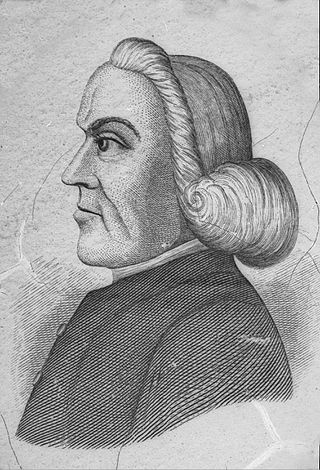Related Research Articles

William Williams, Pantycelyn, also known as William Williams, Williams Pantycelyn, and Pantycelyn, is generally seen as Wales's premier hymnist. He is also rated among the great literary figures of Wales, as a writer of poetry and prose. In religion he was among the leaders of the 18th-century Welsh Methodist revival, along with the evangelists Howell Harris and Daniel Rowland.

Kate Roberts was one of the foremost Welsh-language authors of the 20th century. Styled Brenhines ein llên, she is known mainly for her short stories, but also wrote novels. Roberts was a prominent Welsh nationalist.

Llangeitho is a village and community on the upper River Aeron in Ceredigion, Wales, about four miles west of Tregaron and 11 kilometres (7 mi) north of Lampeter. Its population of 874 in 2001 fell to 819 at the 2011 census.

The Welsh Methodist revival was an evangelical revival that revitalised Christianity in Wales during the 18th century. Methodist preachers such as Daniel Rowland, William Williams and Howell Harris were heavily influential in the movement. The revival led eventually to the establishment of the Welsh Calvinistic Methodists as a denomination and it also revitalised older dissenting churches.

Ann Griffiths was a Welsh poet and writer of Methodist Christian hymns in the Welsh language. Her poetry reflects her fervent Christian faith and thorough scriptural knowledge.

Bronwydd is a village and community in the county of Carmarthenshire, Wales, situated about three miles north of Carmarthen in the valley of the River Gwili. Bronwydd community comprises the village of Bronwydd Arms, a couple of nearby hamlets and a number of working farms in the surrounding area. In Census 2011, it had a population of 564.

Llanpumsaint is a village and community in Carmarthenshire, Wales. In the 2001 UK Census, Llanpumsaint community had a population of 595. It is not to be confused with Pumsaint, a small village some distance away on the River Cothi. The population increased in 2011 to 734, and thus the percentage of Welsh speakers declined.

Tal-y-sarn is a village in the slate quarrying Nantlle Valley in Gwynedd, Wales, next to Penygroes. It is part of the community of Llanllyfni and includes some of Llandwrog. The ward had a population of 1,930 at the 2011 census, the built-up area having a population of 1,086.
This article is about the particular significance of the year 1857 to Wales and its people.
This article is about the particular significance of the year 1850 to Wales and its people.

William Williams, was a Welsh Radical politician.
Jennie Eirian Davies was a Welsh politician and magazine editor.
This article is about the particular significance of the decade 1750 - 1759 to Wales and its people.
Events from the year 1766 in Wales.
Louie Myfanwy Thomas was a Welsh author best known for her work under the pseudonym Jane Ann Jones.
Margaret Thomas was a Welsh hymnwriter.
James Eirian Davies was a Welsh poet and Methodist minister. His wife, Jennie, was a well-known journalist and politician.
"Lament for Lleucu Llwyd" is a Middle Welsh poem by the 14th-century bard Llywelyn Goch ap Meurig Hen in the form of a cywydd. It is his most famous work, and has been called one of the finest of all cywyddau and one of the greatest of all Welsh-language love-poems, comparable with the best poems of Dafydd ap Gwilym. The culmination of a series of poems addressed to his lover Lleucu Llwyd, a married woman, it differs from them in calling her forth from her grave as if he were a more conventional lover serenading her as she lies in bed. The effect is said to be "startling, original, but in no way grotesque". "Lament for Lleucu Llwyd" was included in both The Oxford Book of Welsh Verse and The Oxford Book of Welsh Verse in English.
References
- 1 2 3 Carmarthenshire County Council, Martha Llwyd plaque in Llanpumsaint village park
- 1 2 Aaron, Jane (1 February 2010). Nineteenth-Century Women's Writing in Wales: Nation, Gender and Identity. University of Wales Press. p. 22. ISBN 978-0-7083-2287-1.
- ↑ E. Wyn James, "Merched a'r Emyn yn Sir Gâr", Barn, 402/3 (July/August 1996), p. 29; Thomas, Arwyn (2004) Hanes Llanpumsaint, Carmarthenshire County Council Libraries and Community Learning Section
- ↑ "Merched y gân". BBC Cymru Fyw (in Welsh). 30 May 2017. Retrieved 25 March 2020.
- 1 2 "Cofeb Martha/Honoured at Last" Llais y Pentref/Village Voice (December 2011).
- ↑ Thomas, Arwyn (2004) Hanes Llanpumsaint, Carmarthenshire County Council Libraries and Community Learning Section
- ↑ Davies, Damian Walford (2014). The poets graves = Beddau'r beirdd. Hopwood, Mererid,, White, Paul (Photographer) (Bilingual ed.). Llandysul. ISBN 978-1-84851-739-4. OCLC 874119544.
{{cite book}}: CS1 maint: location missing publisher (link)